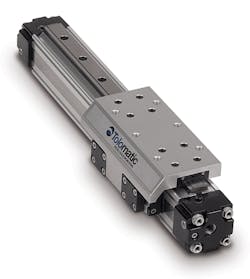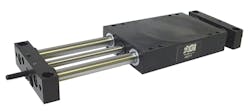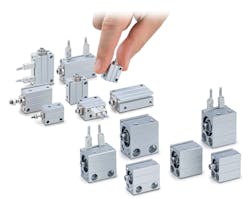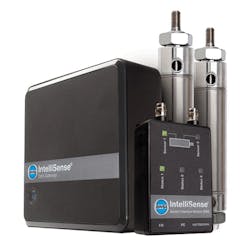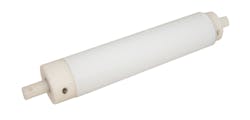Trends in Pneumatic Linear Actuators
This file type includes high resolution graphics and schematics when applicable.
Engines have been using pneumatic actuators to move loads for decades. They are fast, up to 0.5 sec/stroke; powerful, with up to 40,000 lbf behind each stroke; and engineers can easily fine-tune these parameters by adjusting air pressure, valving, and bore size. One of the major advantages of pneumatics over other actuators, namely electromechanical and hydraulic alternatives, is their low cost.
Trends and Capabilities
Still, trends in a host of industries indicate that the growth in pneumatic actuators is in the low single digits, according to Gary Rosengren, director of engineering at Tolomatic Inc., Hamel, Minn., a company that designs and markets pneumatic and electromechanical actuators. “For electromechanical actuators, growth is five times that,” he says. “So clearly the trend is toward electromechanical actuators. That’s because they offer more benefits, including energy efficiency, safety, better control of the motion profile, and lower cost of ownership over the course of the machine’s lifetime.”
“But pneumatics are inexpensive and everyone is looking to save a buck,” notes Rosengren. “And because pneumatics is considered a mature technology, the expectations are for cost to continue to go down. We also see a lot of pressures from offshore sources offering similar pneumatic products for lower prices. They might not have the quality, and that is up for debate, but in most cases, they are not bad. And in many cases, buyers only look at price, not the downstream costs or quality.”
Pneumatic linear actuators offer several other benefits. “They are more reliable than their electromechanical counterparts, and offer a wide variety of sizes and faster actuation times,” says said Peter Farkas, president of American Grippers Inc., Trumbull, Conn., a pneumatic-device manufacturer.
“Pneumatic actuators can also produce considerably more force than their electric counterparts within the same footprint, the cost is much lower, and they’re simple to control,” Farkas explains. “Compressed shop air is readily available in most plants and pneumatics don’t have the added weight of motors and drive mechanisms, so they can fit into limited spaces. Pneumatic actuators can also be held in any position for unlimited time without overheating like electric actuators do, and they do not have limits on duty cycles (rest period) between actuation.”
Safety First
Whenever technicians and employees work close to machinery that moves quickly and with lots of force, there’s always a risk of accidents. “And there’s definitely a trend toward making pneumatic cylinders safer for workers,” says Brad Weedon, online marketing manager for SMC Corp. of America, Noblesville, Ind. “Our company offers many products that can be used as safety-related components for pneumatic actuators, as well as actuators with locks, emergency shut-off valves, and other safety-related equipment.”
However, most of the progress in safety is driven by OSHA directives, according to Jerry Scherzinger, product marketing manager for pneumatics at Bimba Manufacturing Co., University Park, Ill. “Examples include energy dissipation and lock out/tag out,” he says. “OSHA also has specific requirements for safety shutoff valves that regulate specific valve requirements. It is required that valves must be push/pull style for positive shut off of airflow. Rotary valves are not acceptable. Another requirement is that valve exhaust ports must be larger than their input ports to facilitate the rapid dumping of system air pressure (energy dissipation).”
Environmental Pressures
Although pneumatics are considered cleaner than hydraulics, electromechanical actuators are considered cleanest of all. And if environmental regulations become stricter, which they will if EPA continues cracking down on industries, and energy prices rise, pneumatic actuators will likely be replaced by electromechanical actuators.
“There are factories with hundreds of horsepower in compressors running constantly to support actuators and other machinery,” notes Rosengren. “That gobbles up lots of energy, even when the actuators aren’t being used. Electromechanical devices, on the other hand, only use power when they are moving.”
One way factory managers can make pneumatics more “green is to size their compressors to the actual load,” notes Farkas. Making the actuators lighter so that they use less energy is also a valid approach.
Energy use isn’t the only environmental concern, says Rosengren “Pneumatics still need lubricants, and they can be contaminants if they escape into the environment, and that includes the atmosphere,” he says “All the air pressure that goes into a pneumatic cylinder must also go out. And that exhaust, which is similar to the exhaust coming out of the tailpipe of your car, has to be treated because it’s contaminated at some level.”
IoT Activity
While safety and environmental concerns are affecting pneumatic actuators due to stricter regulations, the Internet of Things (IoT) is affecting them by pushing for more sensors and remote controls on industrial equipment and hooking them all together through the Internet.
“Networking machinery, sensors, and control systems together through the IoT will let manufacturing companies improve production and their supply-chain networks in real time,:” explains Farkas. “For pneumatic actuators, adding sensors connected through the Internet will let companies collect useful data on cylinder speed, travel, temperature, and pressure. This information can then be immediately used to optimize production or alert maintenance of an issue before a component fails completely.”
For example, pneumatics manufacturer Bimba has already added more connectivity and monitoring to products such as its IntelliSense in anticipation of a sharp increase in IoT activity. It plans on taking advantage of IoT technology to let its manufacturing customers offer uptime guarantees and enhanced service offerings on the machines they make. “To do this, they must be able to monitor every aspect of their machine’s performance, including that of the pneumatic actuators,” says Bimba’s Scherzinger.
“We already have customers looking to remotely monitor the machines they sell to ensure they are being operated within the design specifications and help reduce warranty claims,” says Scherzinger. “In addition, remote monitoring lets our customers improve future products because they no longer have to rely on companies using their machines to report how those machines are being used. They can see it for themselves.”
Scherzinger also points out that the growing presence of IoT’s influence in other industries has spurred technological development, making sensors, for example, that are more robust and less expensive to embed in traditional pneumatic hardware.
Adding sensors is currently the most significant IoT-related trend for pneumatic actuators, according to SMC’s Weedon. “IoT is becoming more popular in all pneumatics,” notes Weedon. “And for actuators, that typically means adding end-of-stroke sensors. Most of the IoT controls for pneumatics apply to valves and pressure regulators. And the main reason for connecting pneumatic cylinders to the IoT is for predicting failures and scheduling maintenance by tracking cycle speeds and cycle counts. Of course, electric actuators are a more natural fit as IoT devices.”
There has also been a move to add diagnostics to pneumatic actuators, which could be seen as a nod toward IoT. “Adding diagnostics is a relatively new endeavor for pneumatics and is a way to fend off advances in electromechanical actuators to some extent. It is also relatively expensive,” says Tolomatic’s Rosengren. “And the unanswered question is whether the diagnostics will lead to a quicker ROI for the additional expense.”
New Markets for Pneumatics
Pneumatics have long provided a unique set of capabilities, and good engineers should be able to exploit them when an application calls for them. “There will always be applications best served by pneumatics,” notes Rosengren. “There are tasks they can do that electromechanical actuators can’t do, at least not for the same low price. For example, the force and speed one can get with pneumatics are unparalleled in most electromechanical devices. They can go fast and create a lot of power. There will be a need for those attributes for as long as I can imagine.”
For example, pneumatics is a big part of the semiconductor industry and actuators are a large part of that, says Weedon. “Automotive seems to be using more pneumatic actuators as clamps during welding, and the food-packing industry is using more pneumatic cylinders in their processes because it is clean,” he says.
There are also niche applications in which pneumatics should see growth, according to Michael Gust, the industry liaison at the Center for Compact and Efficient Fluid Power. “We see tremendous opportunities for pneumatic-actuation growth in new market growth, particularly in the areas of human-scale assistive fluid power and medical applications,” he says. “Examples include wearable, exoskeleton-like devices to improve human mobility, productivity, and quality of life. Inherent pneumatic properties such as clean, safe, environmentally friendly, portability and ‘usable’ power, that is torque and speeds, align well with these application requirements.”
Another potential growth area pointed out by Gust is use of pneumatic actuators for medical rehabilitation and MRI-compliant surgery and treatment. “Examples include prosthetics such as ankle-foot devices to help with weakened limbs or rehab, and steerable needles for brain surgery,” Gust says. “Pneumatics’ inherent ability to be compliant with MRI chambers, as well as the ready availability of air supplies in hospitals and operating rooms, make this technology very attractive.


